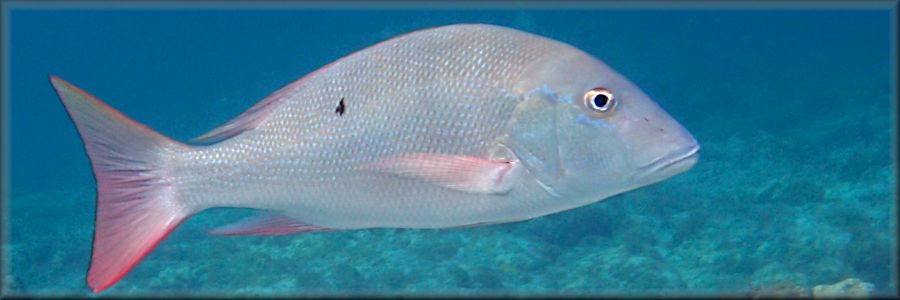How to Snorkel for Underwater Photography
Maximise your snorkeling dive time (part II)
for mammalian dive reflex, start relaxed, dive smoothly and don't hyperventilate
Proper preparation with relaxation will increase dive duration and take your snorkeling photography to a new level
In 3 one-hour lessons, a freedive instructor increased my dive duration by 96%!!!!
What happened? The number of muscles I wasn't using, that were tense, was unbelievable. Included very big muscles such as neck, shoulders and back. When tensed they gobble up oxygen, drastically shortening dive duration.
A good instructor will help you identify and relax those muscles which aren't being used at all. Result is much more photography time.
What happened? The number of muscles I wasn't using, that were tense, was unbelievable. Included very big muscles such as neck, shoulders and back. When tensed they gobble up oxygen, drastically shortening dive duration.
A good instructor will help you identify and relax those muscles which aren't being used at all. Result is much more photography time.
It's so easy to change, relaxing while doing proper breathing before you dive, with major benefits, shown inarguably by the stop watch.
There are so many other little things that make a difference. One example. You can swim in a way so you can still see forward, without arching your neck. This avoids those big, often tense, neck and shoulder muscles eating oxygen.
It sounds like minutiae. 96% more photography time is not minutiae. It is better photographs.
There are so many other little things that make a difference. One example. You can swim in a way so you can still see forward, without arching your neck. This avoids those big, often tense, neck and shoulder muscles eating oxygen.
It sounds like minutiae. 96% more photography time is not minutiae. It is better photographs.
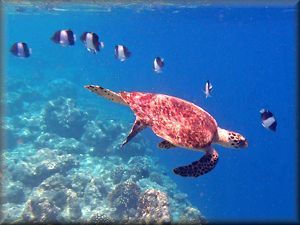
A calm dive starts at the surface
Slow, diaphragm-driven breathes first, for minimal muscle tension. NOT repeated cycles of rapid, deep chest
breaths ie hyperventilating.
Slow heart rate and minimal muscle tension is vital at this stage.
Maintain the calm. Dive causing the least ripples.
Slow heart rate and minimal muscle tension is vital at this stage.
Maintain the calm. Dive causing the least ripples.
Ask your snorkelling buddy about your dive entry.
A calm surface preparation and slide under helps keep the fish calm as well. Seriously.
The guy who goes under like a demented whale will only find fish with a death wish staying anywhere near him.
A calm surface preparation and slide under helps keep the fish calm as well. Seriously.
The guy who goes under like a demented whale will only find fish with a death wish staying anywhere near him.
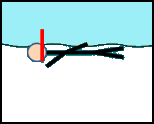
1 - bend at waist so head and torso point down.
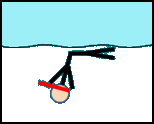
Head has gone from pointing to 3 o'clock
(or 9 o'clock) to 6 o'clock.
(or 9 o'clock) to 6 o'clock.

2 - immediately after, gently nearly straighten legs so
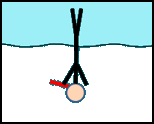
point straight up. Feet have gone from pointing to 3 (or 9) o'clock to 12 o'clock.

3 - gravity ensures you go straight down.
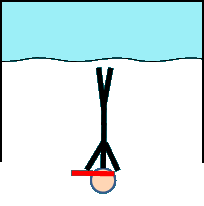
Start kicking gently when your fins are under, although your momentum will take you down.

now equalise your ears as it is easier before pressure builds
Don't hyperventilate before the dive. It can be very bad for your health
Do you really need the theory?
It's not the lack of oxygen in the blood that causes us to want to breathe but the build-up of CO2 [carbon dioxide], which is the result of oxygen being used up in the body.
Several deep inhale - exhale - inhale - cycles before we dive - called hyperventilating - reduces the level of CO2 in the blood. This means that we don't get the urge to breathe as early as we otherwise would, so extending the dive.
So, if this works why not more deep inhales/ exhales cycles - ie hyperventilating? Well...
Normally when oxygen is used up to a certain, or normal, level the CO2 level will have risen to another 'normal' level and you get the urge to breathe.
It's not the lack of oxygen in the blood that causes us to want to breathe but the build-up of CO2 [carbon dioxide], which is the result of oxygen being used up in the body.
Several deep inhale - exhale - inhale - cycles before we dive - called hyperventilating - reduces the level of CO2 in the blood. This means that we don't get the urge to breathe as early as we otherwise would, so extending the dive.
So, if this works why not more deep inhales/ exhales cycles - ie hyperventilating? Well...
Normally when oxygen is used up to a certain, or normal, level the CO2 level will have risen to another 'normal' level and you get the urge to breathe.
This relationship between oxyen and CO2 levels ensures all organs are properly oxygenated.
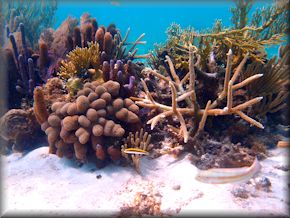 Hyperventilating alters the oxygen to CO2 ratio so the breathing urge
kicks in later than normal when you dive. The oxygen level can plummet below 'normal' before the high CO2 signal kicks in.
Hyperventilating alters the oxygen to CO2 ratio so the breathing urge
kicks in later than normal when you dive. The oxygen level can plummet below 'normal' before the high CO2 signal kicks in.

In extremis, overdoing hyperventilation cycles, results in
not feeling the need to breathe.
It can result in fainting (shallow water blackout). Be warned - Wiki explains it all.
Fortunately it's very rare and avoidable. A few slow, 'diaphragm' breathes at the top. Easy.
Warning signs - light-headedness, numbness, tingling, dizziness or chest pain. Any of those, play it safe and get out for a rest.
The safest way is to simply not push yourself to the extreme.
Don't hyperventilate. Instead, prepare with good breathing and muscle relaxation at the surface, dive and fin calmly, and enjoy a long dive.
It can result in fainting (shallow water blackout). Be warned - Wiki explains it all.
Fortunately it's very rare and avoidable. A few slow, 'diaphragm' breathes at the top. Easy.
Warning signs - light-headedness, numbness, tingling, dizziness or chest pain. Any of those, play it safe and get out for a rest.
The safest way is to simply not push yourself to the extreme.
Don't hyperventilate. Instead, prepare with good breathing and muscle relaxation at the surface, dive and fin calmly, and enjoy a long dive.
